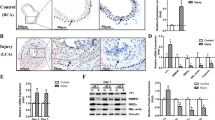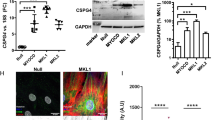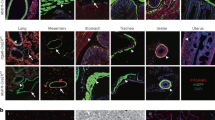Abstract
The transcription factors c-myb and c-myc are essential for vascular smooth muscle cell (VSMC) replication and are rapidly induced following mitogenic stimulation of quiescent VSMCs in vitro and in vivo following balloon catheter injury. Consequently, interference with c-myb and c-myc function provides a possible avenue for the prevention of VSMC proliferation associated with intimal hyperplasia. We have carried out studies focused on the inhibition of VSMC proliferation using dominant-negative gene constructs incorporating the DNA-binding domains of the c-myb or c-myc genes fused to the repressor domain of the Drosophila engrailed gene. Transient transfection of rat, rabbit and human vascular SMCs results in a dramatic inhibition of proliferation for at least 72 h after transfection. Furthermore, this inhibition of cellular proliferation was found to be due, at least in part, to the induction of apoptosis. Coupling expression of the chimeric dominant-negative proteins to transcriptional regulatory elements of the human vascular smooth muscle α-actin gene allows specific targeting of vascular smooth muscle cells.
This is a preview of subscription content, access via your institution
Access options
Subscribe to this journal
Receive 12 print issues and online access
$259.00 per year
only $21.58 per issue
Buy this article
- Purchase on Springer Link
- Instant access to full article PDF
Prices may be subject to local taxes which are calculated during checkout





Similar content being viewed by others
References
CABRI Trial participants . First-year results of CABRI (Coronary angioplasty versus bypass revascularisation investigation) Lancet 1995 346: 1179–1183
Kadel C et al. Long-term follow up after PTCA in patients with single-vessel disease Am Heart J 1992 124: 1159–1169
Libby P . Lesion versus lumen Nature Med 1995 1: 17–18
Casscells W, Engler D, Willerson JT . Mechanisms of restenosis Texas Heart Inst J 1994 21: 68–77
Schwartz RS, Holmes DRJ, Topol EJ . The restenosis paradigm revisited: an alternative proposal for cellular mechanisms Am Coll Cardiol 1992 20: 1284–1293
Andersen HR et al. Remodeling rather than neointimal formation explains luminal narrowing after deep vessel wall injury. Insights from a porcine coronary (re)stenosis model Circulation 1996 93: 1716–1724
Andres V . Control of vascular smooth muscle cell growth and its implication in atherosclerosis and restenosis Int J Mol Med 1998 2: 81–89
Bauters C et al. Proto-oncogene expression in rabbit aorta after wall injury First marker of the cellular process leading to restenosis after angioplasty? Eur Heart J 1992 13: 556–559
Brown KE, Kindy MS, Sonenshein GE . Expression of the c-myb proto-oncogene in bovine vascular smooth muscle cells J Biol Chem 1992 267: 4625–4630
Gadeau AP, Campan M, Desgranges C . Induction of cell-cycle dependent genes during cell cycle progression of arterial smooth muscle cells in culture J Cell Physiol 1991 146: 356–361
Miano JM et al. Early proto-oncogene expression in rat aortic smooth muscle cells following endothelial removal Am J Pathol 1992 137: 761–765
Bennet M, Evan G, Newby A . Deregulated expression of the c-myc oncogene abolishes inhibition of proliferation of rat vascular smooth muscle cells by serum reduction, interferon-gamma, heparin and cyclic nucleotide analogues and induces apoptosis Circ Res 1993 74: 525–538
Taylor D, Badiani P, Weston K . A dominant negative interfering myb mutant causes apoptosis in T cells Genes Dev 1996 10: 2732–2744
Wu M et al. Inhibition of c-myc expression induces apoptosis of WEHI 231 murine B cells Mol Cell Biol 1996 16: 5015–5025
Salomoni P et al. Resistance to apoptosis in CTLL-2 cells constitutively expressing c-Myb is associated with induction of BCL-2 expression and Myb-dependent regulation of bcl-2 promoter activity Proc Natl Acad Sci USA 1997 94: 3296–3301
Bennett RM et al. Inhibition of vascular smooth muscle cell proliferation in vitro and in vivo by c-myc antisense oligodeoxynucleotides J Clin Invest 1994 93: 820–828
Biro S et al. Inhibitory effects of antisense oligodeoxynucleotides targeting c-myc mRNA on smooth muscle cell proliferation and migration Proc Natl Acad Sci USA 1993 90: 654–658
Ebbecke M et al. Antiproliferative effects of a c-myc antisense oligonucleotide on human arterial smooth muscle cells Basic Res Cardiol 1992 87: 585–591
Shi Y et al. Downregulation of c-myc expression by antisense oligonucleotides inhibits proliferation of human smooth muscle cells Circulation 1993 88: 1190–1195
Simons M et al. Antisense c-myb oligonucleotides inhibit intimal arterial smooth muscle cells accumulation in vivo Nature 1992 359: 67–70
Gunn J et al. The effect of oligonucleotides to c-myb on vascular smooth muscle cell proliferation and neointima formation after porcine coronary angioplasty Circ Res 1997 80: 520–531
Shi Y et al. Cellular, molecular, biological and immunological research: transcatheter delivery of c-myb antisense oligomers reduces neointimal formation in a porcine model of coronary artery balloon injury Circulation 1994 90: 944–951
Burgess TL et al. The antiproliferative activity of c-myb and c-myc antisense oligonucleotides in smooth muscle cells is caused by a nonantisense mechanism Proc Natl Acad Sci USA 1995 92: 4051–4055
Villa AE et al. Effects of antisense c-myb oligonucleotides on vascular smooth muscle cell proliferation and response to vessel wall injury Circ Res 1995 76: 505–513
Ho PT, Parkinson DR . Antisense oligonucleotides as therapeutics for malignant diseases Semin Oncol 1997 24: 187–202
Castier Y et al. The activity of c-myb antisense oligonucleotide to prevent intimal hyperplasia is nonspecific J Cardiovasc Surg 1998 39: 1–7
Xin Y, Min W . Retrovirus mediated transfer of antisense human c-myc gene into human esophageal cancer cells suppressed cell proliferation and malignancy Sci China 1992 35: 76–83
Sklar MD et al. Depletion of c-myc with specific antisense sequences reverses the transformed phenotype in ras oncogene-transformed NIH3T3 cells Mol Cell Biol 1991 11: 3699–3710
Fujita M, Shiku H . A human T lymphotropic virus type 1 (HTLV-1) long terminal repeat-directed antisense c-myc construct with an Epstein–Barr virus replicon vector inhibits cell growth in a HTLV-1-transformed human T cell line FEBS Letts 1991 322: 15–20
Indolfi C et al. Inhibition of cellular ras prevents smooth muscle cell proliferation after vascular injury in vivo Nature Med 1995 1: 541–545
Ueno H et al. Adenovirus-mediated transfer of a dominant-negative H-ras suppresses neointimal formation in balloon-injured arteries in vivo Arterioscler Thromb Vasc Biol 1997 17: 898–904
Chang MW et al. Cytostatic gene therapy for vascular proliferative disorders with a constitutively active form of the retinoblastoma gene product Science 1995 267: 518–522
Badiani P et al. Dominant interfering alleles define a role for c-myb in T-cell development Genes Dev 1994 8: 770–782
Husain M et al. c-myb-dependent cell cycle progression and Ca2+ storage in cultured vascular smooth muscle cells Circ Res 1997 80: 617–626
Jaynes JB, O’Farrell PH . Active repression of transcription by the engrailed homeodomain protein EMBO J 1991 10: 1427–1433
Amati B, Land H . Myc-Max-Mad: a transcription factor network controlling cell cycle progression, differentiation and death Curr Opin Genet Dev 1994 4: 102–108
Amati B et al. Oncogenic activity of the c-Myc protein requires dimerization with Max Cell 1993 72: 233–245
Mukherjee B, Morgenbesser SD, DePinho R . Myc family oncoproteins function through a common pathway to transform normal cells in culture: cross-interference by Max and transacting dominant mutants Genes Dev 1992 6: 1480–1492
Keogh M-C et al. Design of a muscle cell-specific expression vector utilising human VSMC α-actin regulatory elements Gene Therapy 1999 6: 616–628
Keogh M-C et al. High efficiency reporter gene transfection of vascular tissue in vitro and in vivo using a cationic lipid–DNA complex Gene Therapy 1997 4: 162–171
Vincent S, Marty L, Fort P . S26 ribosomal protein RNA: an invariant control for gene regulation experiments in eukaryotic cells and tissues Nucleic Acids Res 1993 21: 1498
Pavlik EJ et al. Antagonism to estradiol in the mouse: reduced entry of receptors complexed with 4-hydroxytamoxifen into a Mg2+-soluble chromatin fraction Endocrinology 1986 118: 1124–1134
Amati B et al. The c-Myc protein induces cell cycle progression and apoptosis through dimerization with Max EMBO J 1993 12: 5083–5087
Green DR . A Myc-induced apoptosis pathway surfaces Science 1997 278: 1246–1247
Sonenshein GE . Down-modulation of c-myc expression induces apoptosis of B lymphocyte models of tolerance via clonal deletion J Immunol 1997 158: 1994–1997
Littlewood TD et al. A modified oestrogen receptor ligand-binding domain as an improved switch for the regulation of heterologous proteins Nucleic Acids Res 1995 23: 1686–1690
Bochaton-Piallat M et al. Apoptosis participates in cellularity regulation during rat aortic intimal thickening Am J Pathol 1995 146: 1059–1064
Hamet P et al. The time window of apoptosis: a new component in the therapeutic strategy for cardiovascular remodeling J Hypertens 1996 14: S65–S70
Isner JM et al. Apoptosis in human atherosclerosis and restenosis Circulation 1995 91: 2703–2711
Acknowledgements
These studies were supported by funding from the Garfield Weston Foundation. We would like to thank the Liver Transplant Unit, Kings College Hospital and the Royal Brompton Hospital for supplying human arteries. We would also like to thank the staff of the immunohistochemistry laboratory, TRI for their aid and technical expertise.
Author information
Authors and Affiliations
Rights and permissions
About this article
Cite this article
Schmitt, J., Keogh, MC., Dennehy, U. et al. Tissue-selective expression of dominant-negative proteins for the regulation of vascular smooth muscle cell proliferation. Gene Ther 6, 1184–1191 (1999). https://doi.org/10.1038/sj.gt.3300927
Received:
Accepted:
Published:
Issue Date:
DOI: https://doi.org/10.1038/sj.gt.3300927



